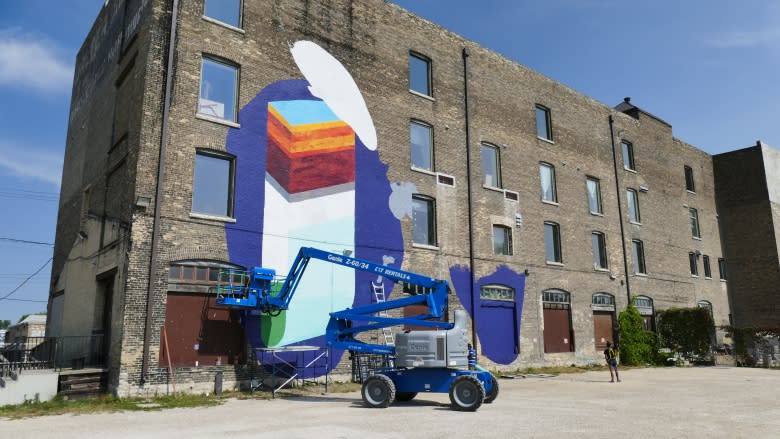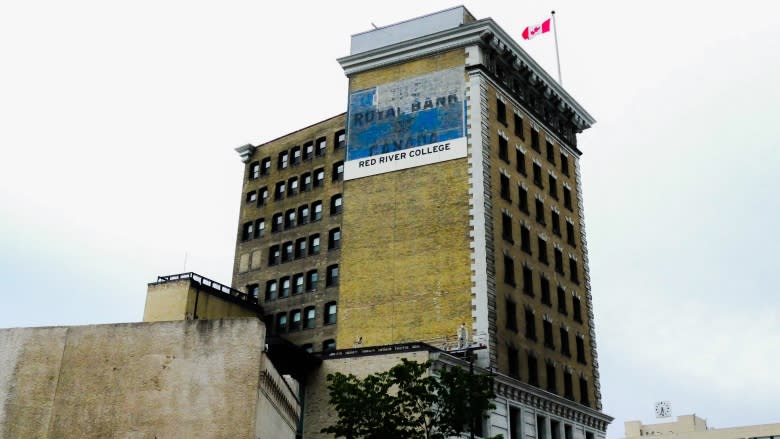Heritage status could dash dreams of future murals at North Point Douglas church, pastor says
John Rademaker loves the beautiful storeys-high Indigenous murals that adorn the sides of his North Point Douglas church and wants to add more, but he says that won't be possible if the city extends heritage status to the building against his wishes.
"The biggest reason is that we feel that it is going to be a restriction to what it is we are actually doing in the community," said Rademaker, pastor of Winnipeg Centre Vineyard Church on Sutherland Avenue and Main Street.
"The problem is they will not let us paint another mural on the building, which is an absolute downer for us, it's a negative."
The 114-year-old building has been home to the church for 14 years but was previously the warehouse for the International Harvester Company, which the city describes as "world leaders in the manufacturing of farm equipment and trucks."
The warehouse was built in 1904 in the Classical Revival style, with a heavy timber beam backbone and dark brick walls, and stands out where train tracks separate the Exchange District from North Point Douglas.
It's still in great shape and fits the criteria for heritage status, according to the city's historical buildings and resources committee, which nominated the building for the designation.
A report to the city's property development and heritage committee recommends protecting the building, and identifies the brick and timber as heritage characteristics.
Rademaker says he learned from a city official the church will no longer be able to cover its outside brick walls with art if the building is granted heritage status.
Award-winning mural
Two massive murals went up on the south side wall of the building in 2016 as part of a North End revitalization project.
One northern-inspired piece features two narwhals; the other, an award-winning piece titled Mending, shows an Indigenous woman trying to stitch up a broken heart.
"We're trying to connect with people. The majority of the people that are in our community are dealing with issues of brokenness … and we're just trying to be there for them," said Rademaker.
"There's different ways to speak with people. You don't just throw them a big sermon on a Sunday morning, you connect with them by being relational in whatever way they will accept it.
"The mural … has done that and more."
The church also operates 32 transitional housing beds and hopes to expand to the vacant fourth floor to add more beds. That would require putting in plumbing and some other construction, but Rademaker worries that, too, would be restricted if the building gets the historical designation.
"It's even a way bigger deal than the murals," he said.
"Housing is the most pressing need for the people who are marginalized in the poverty zone in the core area. Once you get housing sorted out, a lot of other things fall into place."
Cindy Tugwell, executive director of Heritage Winnipeg, an advocacy group that is independent of the city, said there is often confusion on the part of property owners in terms of what limitations on development come with the heritage designation.
The only restriction on development inside the building in this case, she said, would be related to the big timber beams, which have been identified as a key historical feature.
Rademaker said the church wouldn't touch those anyway.
Designation fights common
It isn't rare for building owners to fight the designation process. Tugwell estimates half of owners oppose historical status, as has Rademaker, who already paid a lawyer to research his options for stopping the process.
Tugwell said there are upwards of 1,000 buildings in Winnipeg worthy of heritage status, though only 303 have officially gone through the process to get the special designation, according to the city's website. There were 65 properties nominated on the city website.
As for future art Rademaker has planned on the outside of the building, Tugwell says the restrictions on altering the facade or exteriors of a heritage-designated building are there for a reason.
"We all don't get exactly what we want," she said.
"Our goal is to protect the building for future generations and future Winnipegs, to continue to be an integral part of the streetscape, and not just to be selfish that whomever owns it at this time feels they can do whatever they want to it.
"Heritage buildings that are designated and protected are for everyone, not just the people who own them."
'Compromise' with canvas
She said "compromise" is the operative word, and said other heritage building owners have opted to drape art-covered canvas or other materials over their building sides.
She said the old Royal Bank building on Main Street that is now home to Red River College's culinary school is a good example of a "ghost sign" that has since been covered with a fabric or canvas sign.
But while that approach may work for a sign for the college, Rademaker says world-class muralists aren't interested in painting on material.
"The city is saying 'do it on a canvas and put it on the wall.' Well, we're not interested in doing that, because that will mean that we're going to end up with some chalky amateur artwork situation," he said.
Ultimately it's the city, not Heritage Winnipeg, that will make the call. Rademaker and Tugwell both plan to be present Monday as the recommendation is presented to the city's standing policy committee.
A city spokesperson said owners of nominated buildings are free to make certain alterations such as painting exteriors. If the building eventually ends up with the designation though, and the exteriors are among the "character-defining elements" that may not be changed, then the owner has to apply for a permit to do something like repaint or do a mural on an outside wall.
One thing that differentiates the Vine yard Church pieces from other buildings in downtown with faded ghost signs from decades past is that its murals weren't part of the original building design.
Even so, were a building such as the church to get designated and down the line wanted to just freshen up its two existing pieces, there's an expectation the owner would notify the city so it could "assess the suitability of the project," the city spokesperson added.



